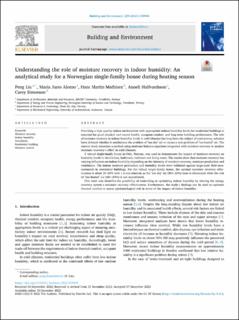| dc.contributor.author | Liu, Peng | |
| dc.contributor.author | Justo Alonso, Maria | |
| dc.contributor.author | Mathisen, Hans Martin | |
| dc.contributor.author | Halfvardsson, Anneli | |
| dc.contributor.author | Simonson, Carey J. | |
| dc.date.accessioned | 2023-01-01T09:49:51Z | |
| dc.date.available | 2023-01-01T09:49:51Z | |
| dc.date.created | 2022-12-19T21:21:14Z | |
| dc.date.issued | 2022 | |
| dc.identifier.issn | 0360-1323 | |
| dc.identifier.uri | https://hdl.handle.net/11250/3040135 | |
| dc.description.abstract | Providing a high-quality indoor environment with appropriate indoor humidity levels for residential buildings is essential for good physical and mental health, occupant comfort, and long-term building performance. The role of moisture recovery in indoor humidity levels in cold climates has long been the subject of controversy; scholars have debated whether it ameliorates the problem of "too dry" air or causes a new problem of "too humid" air. The current study examines a method using moisture balance equations integrated with moisture recovery to analyse moisture recovery's effect in cold climates.
A virtual single-family house in Oslo, Norway, was used to demonstrate the impact of moisture recovery on humidity levels in the kitchen, bathroom, bedroom and living room. The results show that moisture recovery has varying influences on indoor humidity depending on the intensity of moisture recovery, moisture production and ventilation. The indoor moisture production and humidity levels were validated against large-scale field measurements in residential buildings. For the virtual single-family house, the optimal moisture recovery effectiveness is about 50–60% with a 2-min interval, as the "too dry" air (RH<20%) issue is eliminated while the risk of "too humid" air (RH>80%) is not exacerbated.
This work also identifies the possibility of controlling or optimising indoor humidity by altering the energy recovery system's moisture recovery effectiveness. Furthermore, the study's findings can be used to optimise thermal comfort or assess epidemiological risk in terms of the impact of indoor humidity. | en_US |
| dc.language.iso | eng | en_US |
| dc.publisher | Elsevier | en_US |
| dc.rights | CC BY 4.0 | * |
| dc.rights.uri | http://creativecommons.org/licenses/by/4.0 | * |
| dc.subject | Moisture recovery | en_US |
| dc.subject | Indoor humidity | en_US |
| dc.subject | Ventilation | en_US |
| dc.subject | Residential building | en_US |
| dc.subject | Moisture control | en_US |
| dc.title | Understanding the role of moisture recovery in indoor humidity: An analytical study for a Norwegian single-family house during heating season | en_US |
| dc.title.alternative | Understanding the role of moisture recovery in indoor humidity: An analytical study for a Norwegian single-family house during heating season | en_US |
| dc.type | Peer reviewed | en_US |
| dc.type | Journal article | en_US |
| dc.description.version | publishedVersion | en_US |
| dc.rights.holder | © 2022 The authors | en_US |
| dc.subject.nsi | VDP::Teknologi: 500 | en_US |
| dc.source.volume | 229 | en_US |
| dc.source.journal | Building and Environment | en_US |
| dc.identifier.doi | 10.1016/j.buildenv.2022.109940 | |
| dc.identifier.cristin | 2095440 | |
| dc.relation.project | Norges forskningsråd: 296489 | en_US |
| dc.source.articlenumber | 109940 | en_US |
| cristin.ispublished | true | |
| cristin.fulltext | original | |
| cristin.qualitycode | 2 | |

